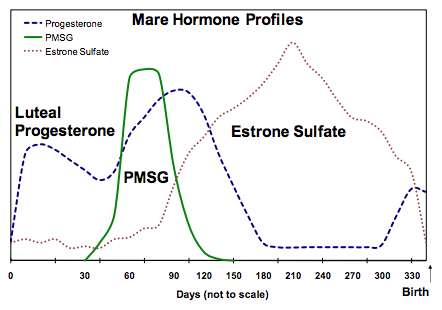Equine Female Reproductive Testing
Single or Baseline Tests Available
Progesterone (P4), PMSG, Estrone Sulfate (E1S)
These tests can be used singly or in combination to assess pregnancy in mares. A combination of these tests may be useful in determining possible conception dates for mares with unknown histories, i.e., pasture bred, bought at auction, rescued. Baseline progesterone levels are often useful in mares with a history of early embryonic loss. For mares confirmed pregnant early in gestation and not pregnant later, PMSG and/or estrone sulfate may be useful in determining whether or not placentation was established.
Progesterone Baseline: Days 14-45
Progesterone analysis in serum samples is useful for distinguishing the different reproductive states of mares and it may be used to support diagnosis and monitoring of pregnancy. The expected stage of the cycle and the number of days post-breeding is very important when using this test for early pregnancy diagnosis. For example, using our test and established reference ranges, a low progesterone result in a potentially pregnant mare on a day when it would otherwise be expected to be in estrus 16 to 90 days after breeding would indicate non-pregnancy. Progesterone should not be used for monitoring mid and late trimesters of equine pregnancy, as other progestins maintain the pregnancy. Regumate does not cross-react with our assay.
PMSG Baseline: Days 45-100
Pregnant mare serum gonadotropin (PMSG), also known as equine chorionic gonadotropin (eCG), is a hormone that is secreted by the endometrial cups formed in the mare uterus ~40 days after conception. Concentration of PMSG is measurable in most mares by day 45, rises rapidly and peaks at about 60 days, and is no longer detectable 100 - 150 days post-conception. This test is useful for the assessment of conception and endometrial cup formation. We recommend that samples for the PMSG test be collected 45 to 100 days after breeding for accurate results. False positives can occur if the embryo dies after the endometrial cups are established - these mares won’t cycle and will have high levels of PMSG until levels naturally decrease sometime after 100 days post-conception. It is strongly recommended that this test be followed by Estrone Sulfate testing or palpation to confirm pregnancy and fetal well being after 100 days. This test cannot be used for donkeys.
Estrone Sulfate Baseline: Days 90-Term
The Estrone sulfate test is very useful and accurate for diagnosing pregnancy in mares from day 90 to term. Estrone sulfate is produced by the fetal-placental unit and is therefore a good indicator of fetal well-being. Some maiden or older mares at 90 to 120 days of pregnancy may have equivocal results as placentation is established. These mares should be rechecked after a month to confirm pregnancy. Estrone sulfate results slightly below or low normal pregnant range in mid- to late-gestation mares may indicate placentitis, severe stress, etc. These mares should be treated appropriately to prevent pregnancy loss. Late pregnant donkeys may have false negative results.
Guidelines for Sample Collection and Processing:
- Collect blood into a plain red-top collection tube. Refrigerate sample.
- Allow blood adequate time to clot prior to centrifugation to ensure sufficient yield and avoid fibrin formation.
- After centrifugation, transfer the serum into a vial suitable for shipping or frozen storage. Frozen sample storage is recommended unless samples are being shipped the day taken.
-
Ship samples with cold packs. A frozen specimen is not necessary, but the sample should arrive chilled.
Note: Equine progesterone can be metabolized when left on red blood cells and stored at room temperature for more than day.


